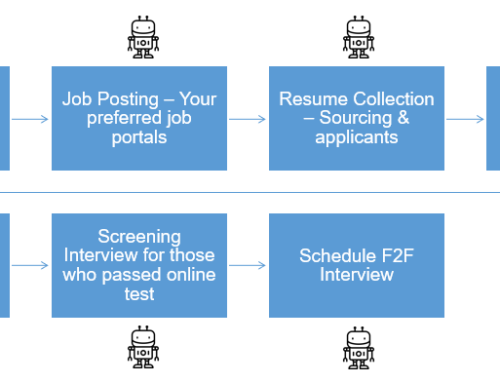
Today, more than ever, the speed of delivery is a differentiating factor for the success of any organization wanting to maintain an edge over the competition. As organizations are under pressure to shrink the time to market for their products and services, my case is that the best way to move forward is to automate business processes. This will boost the quality and consistency, reduce errors, and save costs. I’m even willing to say that automating business processes is no longer an option but a necessity for organizations of all sizes looking to move to higher levels of revenues and profitability. The age of Business Process Automation (BPA) is upon us already.
BUSINESS PROCESS AUTOMATION
According to insights from McKinsey & Company, a trend of corporate business automation is seen in leading technology companies, such as Facebook and Amazon have been early adopters of BPA, and have already reaped the benefits. These companies, for instance, make hundreds of changes to their servers or websites without any downtime. Automation is at the core of their efficiency. This is to be expected, considering that technology drives not only their business offerings but also in many ways their business itself. But the movement is wider than just technology companies.
Over the last decade, the focus has been on ways to streamline business processes (process optimization or re-engineering) to increase efficiency and improve the user experience. Today, newer technologies including Robotic Process Automation (RPA) are bringing about transformational changes across industries.
According to a recent market research report published by Transparency Market Research, the global IT robotic automation market will reach a value of US$16,884.0 million by 2024, expanding at a CAGR of 47.1% between 2016 and 2024. Geographically, process automation technologies have been adopted by most parts of North America, closely followed by Europe and in the Asia-Pacific regions. Technologically advanced countries, such as Japan and China are in the forefront in adopting process automation in their region. Furthermore, owing to the IT boom in developing countries, such as India and Philippines, IT robotic automation is expected to grow favorably in these areas in the near future.
Software-driven automation is being widely used with data-driven and rule-based processes. This helps in improving productivity and compliance accuracy, and can, of course, be applied across various industries. It has enabled various core business processes, support processes, workflow processes, and back-office processes to be managed in a cost-effective manner. Let me use this post to outline just where rules-based automation is making an impact already.
DEVOPS: CONTINUOUS INTEGRATION, CONTINUOUS TESTING, CONTINUOUS DELIVERY
The whole DevOps movement makes continuous delivery possible. Each part of an end-to-end delivery pipeline – right from requirements, development, testing, deployment, infrastructure monitoring, disaster recovery and business continuity – all need to come together in a symphony to make this possible. This approach to continuously delivering enhanced versions of the software product by tightly integrating the development, testing and operations relies heavily on automation all across the DevOps pipeline.
Obviously, automated continuous testing is the go-to option today for software development as well as end-user organizations. It is already widely acknowledged that if done thoughtfully, this saves time and costs, helps in early bug detection, is reusable, and improves the test coverage by covering different complex test cases during each test run. Automated testing can also be used to simulate large volumes of data and the actions of large numbers of virtual users, interacting with a network, software, and web applications, more efficiently than with manual testing.
INSURANCE
In the insurance industry, automated processes are used for checking policy renewal, recalculating policy premiums, early detection of fraud and loss, and data gathering. Automating these routine processes has resulted in fewer errors and reduced operational costs. The insurance company staff can now focus their time and attention on their new customers and on improving their core business.
BANKS AND FINANCIAL SERVICES
Banks and other financial services have automated a wide array of processes, such as making new account entries, generating reports, sending notification emails and messages to clients, processing of credit card orders. Another key use-case is in early fraud detection by tracking account activity, purging known old data, and so on. This has allowed these institutions to achieve significant operational efficiency, scale, and resilience.
CUSTOMER CARE PORTALS
Using online customer care portals, users can now make changes to their investment options, or make ticket bookings, order products, or take an online training without the need for any human intervention.
Most organizations have automated their front-line customer facing operations using software-driven Interactive Voice Response (IVR) Systems. This helps them to reduce cost and provide 24X7 support. These systems guide customers by accepting key tone or voice-based responses and pass on instructions to the underlying application to complete a transaction. Similarly, optical character recognition (OCR) technology has been around for a while now. This helps save a lot of time and effort when creating, processing and repurposing various documents.
IT BACK OFFICE PROCESSES
Many organizations have automated their batch processing and night-time data center operations. Organizations can thus manage their night time operations with minimal staff on duty. This has become a huge opportunity considering how many large enterprises have geographically distributed support centers, strategically located to take advantage of the 24-hour day. I am personally aware of cases where RPA has helped cut the processing time of sales incentive calculations from 2 man-days to 2 hours. This is a favorite area of mine – I can think of so much more to talk about here but maybe in future posts.
OTHER AREAS
Business process automation is also being widely applied to various other roles, functions, and departments, such as finance, HR, data entry, inventory management, shipping, purchasing, and billing. In a nutshell, there is the potential for almost universal applicability in making repetitive business processes more predictable and manageable.
CONCLUSION
Business process automation is no longer the future – it’s the present, and in many ways, it’s now the imperative! While it certainly does not eliminate the need for human workers, it does eliminate the need for humans to perform routine, uninteresting, repetitive tasks that require little or no judgement. It provides an opportunity for enterprises to focus their workforce on higher value activities. It promises better returns, improved performance, agility, and quality. As the use cases for automation are increasing by the day, more and more enterprises are embracing the wave of software-driven automation to reap its benefits – is it time for you to join them?
ASK US QUESTIONS
Do you have any views or questions?
Categories
Enterprise Automation, DevOps, RPA, Process Automation, Continuous Integration, BFSI



